Power BI Connector for Talend Studio
Connect to your Power BI account and retrieve data, refresh datasets, etc.
In this article you will learn how to quickly and efficiently integrate Power BI data in Talend Studio without coding. We will use high-performance Power BI Connector to easily connect to Power BI and then access the data inside Talend Studio.
Let's follow the steps below to see how we can accomplish that!
Power BI Connector for Talend Studio is based on ZappySys API Driver which is part of ODBC PowerPack. It is a collection of high-performance ODBC drivers that enable you to integrate data in SQL Server, SSIS, a programming language, or any other ODBC-compatible application. ODBC PowerPack supports various file formats, sources and destinations, including REST/SOAP API, SFTP/FTP, storage services, and plain files, to mention a few.
Create Data Source in ZappySys Data Gateway based on API Driver
-
Download and install ODBC PowerPack.
-
Search for gateway in start menu and Open ZappySys Data Gateway:

-
Go to Users Tab to add our first Gateway user. Click Add; we will give it a name tdsuser and enter password you like to give. Check Admin option and click OK to save. We will use these details later when we create linked server:

-
Now we are ready to add a data source. Click Add, give data source a name (Copy this name somewhere, we will need it later) and then select Native - ZappySys API Driver. Finally, click OK. And it will create the Data Set for it and open the ZS driver UI.
PowerBiDSN

-
When the Configuration window appears give your data source a name if you haven't done that already, then select "Power BI" from the list of Popular Connectors. If "Power BI" is not present in the list, then click "Search Online" and download it. Then set the path to the location where you downloaded it. Finally, click Continue >> to proceed with configuring the DSN:
PowerBiDSNPower BI
-
Now it's time to configure the Connection Manager. Select Authentication Type, e.g. Token Authentication. Then select API Base URL (in most cases, the default one is the right one). More info is available in the Authentication section.
Power BI authentication
Use delegated access (User Credentials) whenever you want to let a signed-in user work with their own resources or resources they can access. Whether it's an admin setting up policies for their entire organization or a user deleting an email in their inbox, all scenarios involving user actions should use delegated access. [API reference]
Follow these simple steps below to create Microsoft Entra ID application with delegated access:
WARNING: If you are planning to automate processes, we recommend that you use a Application Credentials authentication method. In case, you still need to use User Credentials, then make sure you use a system/generic account (e.g.automation@my-company.com). When you use a personal account which is tied to a specific employee profile and that employee leaves the company, the token may become invalid and any automated processes using that token will start to fail.- Navigate to the Azure Portal and log in using your credentials.
- Access Microsoft Entra ID.
-
Register a new application by going to App registrations and clicking on New registration button:
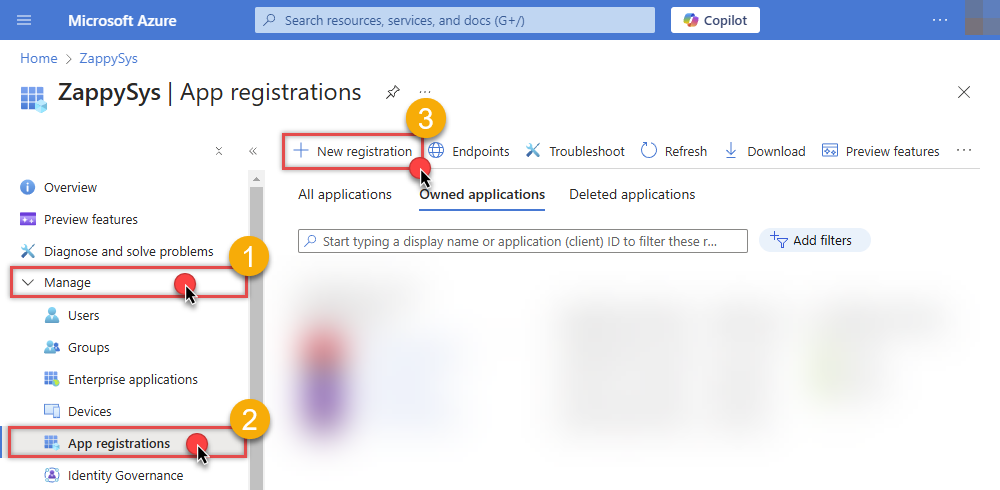 INFO: Find more information on how to register an application in Graph API reference.
INFO: Find more information on how to register an application in Graph API reference. -
When configuration window opens, configure these fields:
-
Supported account type
- Use
Accounts in this organizational directory only, if you need access to data in your organization only.
- Use
-
Supported account type
-
Redirect URI:
- Set the type to
Public client/native (mobile & desktop). - Use
https://zappysys.com/oauthas the URL.
- Set the type to
-
After registering the app, copy the Application (client) ID for later:
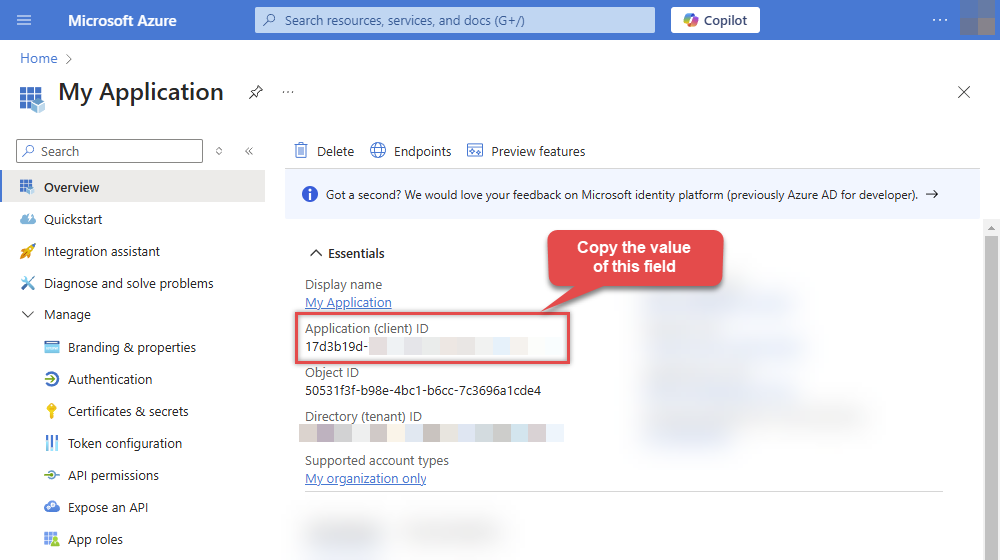
-
Copy OAuth authorization endpoint (v2) & OAuth token endpoint (v2) URLs to use later in the configuration:
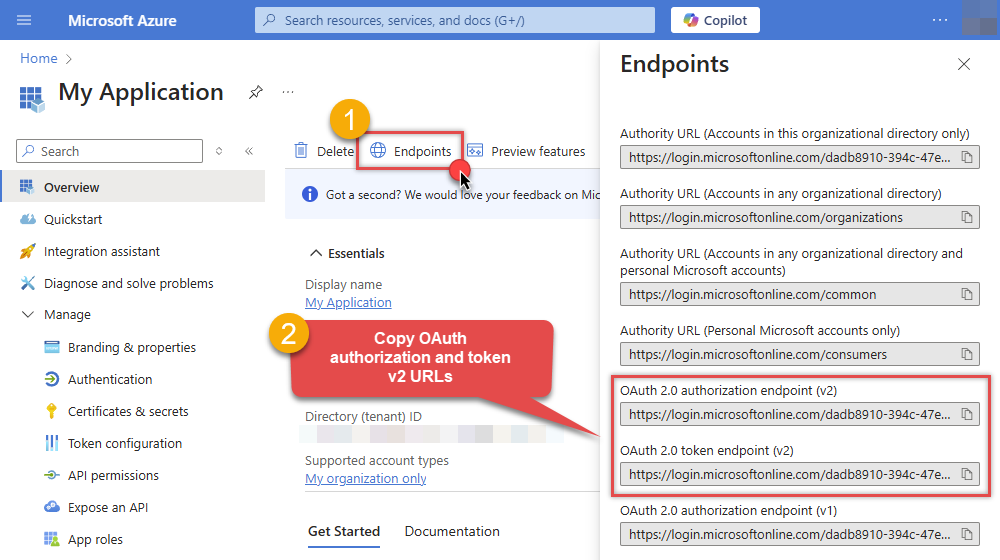
-
Now go to SSIS package or ODBC data source and use the copied values in User Credentials authentication configuration:
- In the Authorization URL field paste the OAuth authorization endpoint (v2) URL value you copied in the previous step.
- In the Token URL field paste the OAuth token endpoint (v2) URL value you copied in the previous step.
- In the Client ID field paste the Application (client) ID value you copied in the previous step.
-
In the Scope field use the default value or select individual scopes, e.g.:
-
offline_access -
https://analysis.windows.net/powerbi/api/Workspace.Read.All -
https://analysis.windows.net/powerbi/api/Dataset.Read.All -
https://analysis.windows.net/powerbi/api/Dataset.ReadWrite.All
-
- Press Generate Token button to generate Access and Refresh Tokens.
- Click Test Connection to confirm the connection is working.
- Optional step. Choose Default Workspace from the drop down menu.
- Choose Default Dataset from the drop down menu.
- Done! Now you are ready to use the API Connector!

API Connection Manager configuration
Just perform these simple steps to finish authentication configuration:
-
Set Authentication Type to
User Credentials [OAuth] - Optional step. Modify API Base URL if needed (in most cases default will work).
- Fill in all the required parameters and set optional parameters if needed.
- Press Generate Token button to generate the tokens.
- Finally, hit OK button:
PowerBiDSNPower BIUser Credentials [OAuth]https://api.powerbi.com/v1.0/myorgRequired Parameters Authorization URL Fill-in the parameter... Token URL Fill-in the parameter... Client ID Fill-in the parameter... Scope Fill-in the parameter... Default Dataset (select after generating tokens) Fill-in the parameter... Optional Parameters Client Secret Redirect URI (must match App Redirect URI) Default Workspace (Keep Empty for My Workspace - select after generating tokens) RetryMode RetryWhenStatusCodeMatch RetryStatusCodeList 429|503 RetryCountMax 20 RetryWaitTimeMs 1000 RetryMultiplyWaitTime True Login options 
-
Once the data source connection has been configured, it's time to configure the SQL query. Select the Preview tab and then click Query Builder button to configure the SQL query:
 ZappySys API Driver - Power BIConnect to your Power BI account and retrieve data, refresh datasets, etc.PowerBiDSN
ZappySys API Driver - Power BIConnect to your Power BI account and retrieve data, refresh datasets, etc.PowerBiDSN
-
Start by selecting the Table or Endpoint you are interested in and then configure the parameters. This will generate a query that we will use in Talend Studio to retrieve data from Power BI. Hit OK button to use this query in the next step.
SELECT * FROM Workspaces WHERE Id='aaaaaaaa-bbbb-cccc-dddd-eeeeeeeeeeee' Some parameters configured in this window will be passed to the Power BI API, e.g. filtering parameters. It means that filtering will be done on the server side (instead of the client side), enabling you to get only the meaningful data
Some parameters configured in this window will be passed to the Power BI API, e.g. filtering parameters. It means that filtering will be done on the server side (instead of the client side), enabling you to get only the meaningful datamuch faster . -
Now hit Preview Data button to preview the data using the generated SQL query. If you are satisfied with the result, use this query in Talend Studio:
 ZappySys API Driver - Power BIConnect to your Power BI account and retrieve data, refresh datasets, etc.PowerBiDSN
ZappySys API Driver - Power BIConnect to your Power BI account and retrieve data, refresh datasets, etc.PowerBiDSNSELECT * FROM Workspaces WHERE Id='aaaaaaaa-bbbb-cccc-dddd-eeeeeeeeeeee' You can also access data quickly from the tables dropdown by selecting <Select table>.A
You can also access data quickly from the tables dropdown by selecting <Select table>.AWHEREclause,LIMITkeyword will be performed on the client side, meaning that thewhole result set will be retrieved from the Power BI API first, and only then the filtering will be applied to the data. If possible, it is recommended to use parameters in Query Builder to filter the data on the server side (in Power BI servers). -
Click OK to finish creating the data source.
-
Most Important Step: Now, After creating or modifying a data source in ZappySys Data Gateway, make sure to click the SAVE button to preserve your changes.
Then, RESTART the Data Gateway service to ensure all changes are properly applied.Skipping either step may result in the new settings not taking effect.

Read Power BI data in Talend Studio
To read Power BI data in Talend Studio, we'll need to complete several steps. Let's get through them all right away!
Create connection for input
- First of all, open Talend Studio
-
Create a new connection:
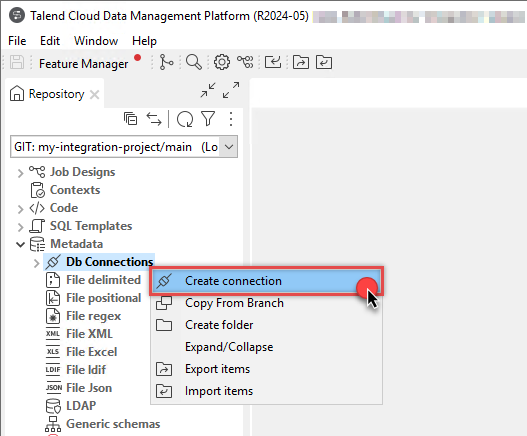
-
Select Microsoft SQL Server connection:
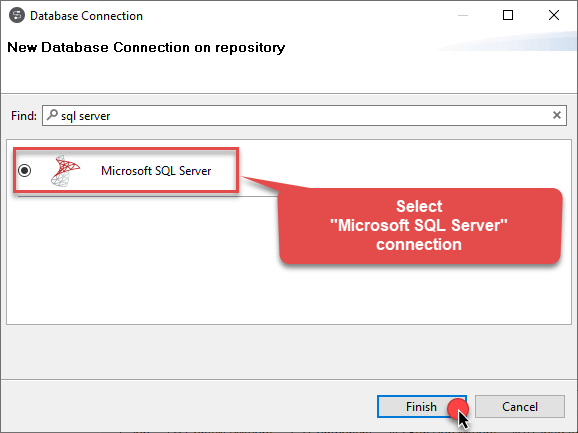
-
Name your connection:

-
Fill-in connection parameters and then click Test connection:
PowerBiDSN
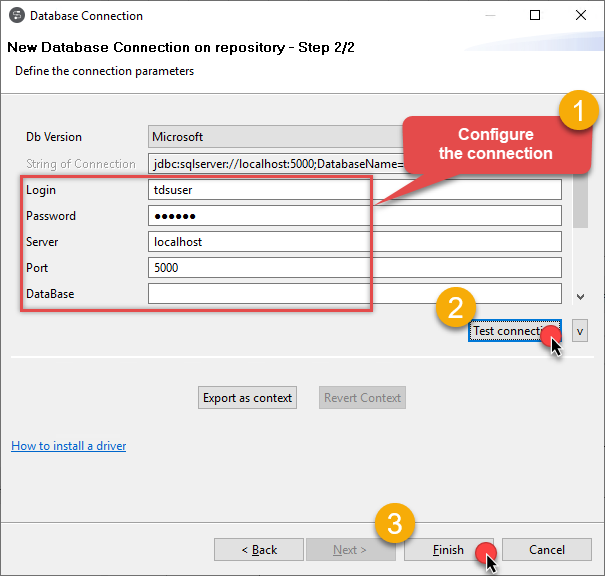
-
If the List of modules not installed for this operation window shows up, then download and install all of them:
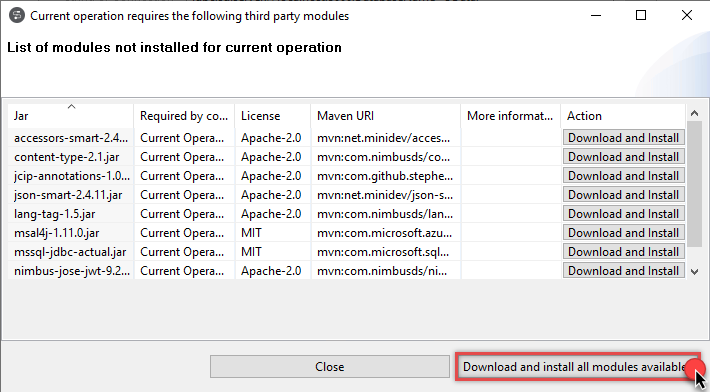 Review and accept all additional module license agreements during the process
Review and accept all additional module license agreements during the process -
Finally, you should see a successful connection test result at the end:

Add input
-
Once we have a connection to ZappySys Data Gateway created, we can proceed by creating a job:
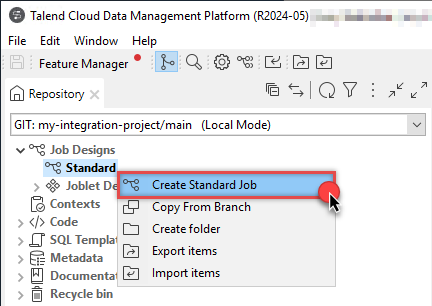
-
Simply drag and drop ZappySys Data Gateway connection onto the job:
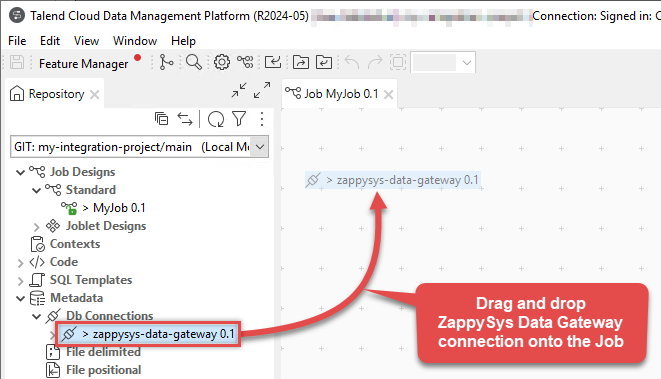
-
Then create an input based on ZappySys Data Gateway connection:
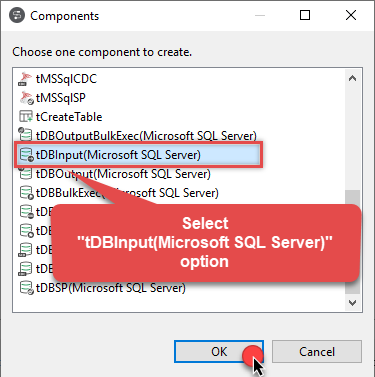
-
Continue by configuring a SQL query and click Guess schema button:
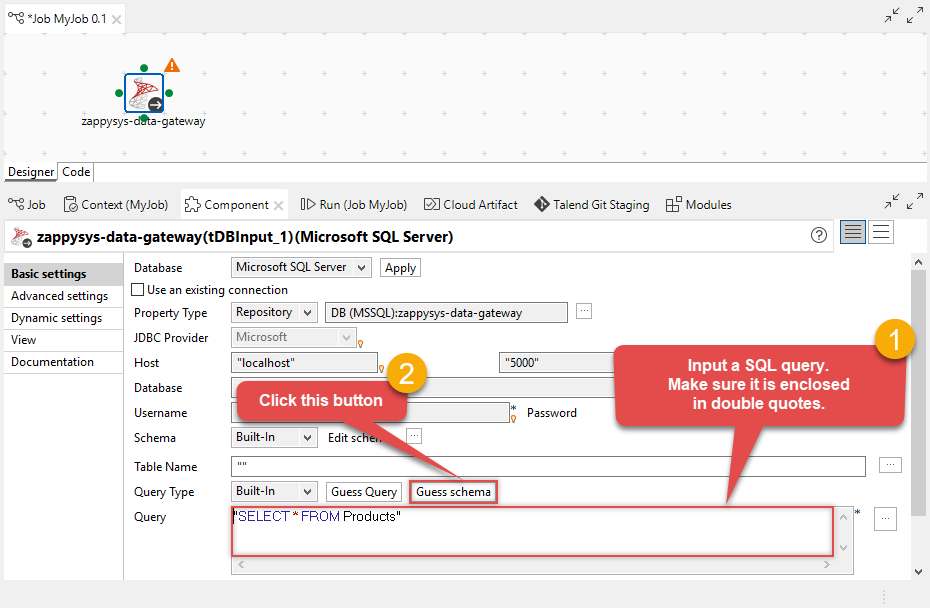
-
Finish by configuring the schema, for example:
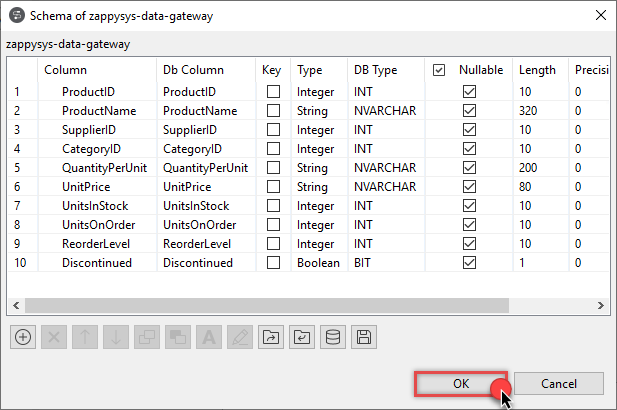
Add output
We are ready to add an output. From Palette drag and drop a tFileOutputDelimited output and connect it to the input: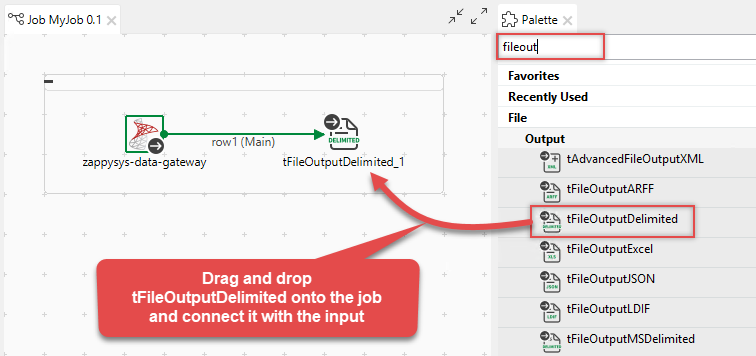
Run the job
Finally, run the job and integrate your Power BI data:
Actions supported by Power BI Connector
Learn how to perform common Power BI actions directly in Talend Studio with these how-to guides:
- Create a Push Dataset
- Delete a Dataset
- Execute a DAX query
- Get a Dataset
- Get a Workspace
- Get Dataflows
- Get Datasets
- Get Table Columns
- Get Table Rows
- Get Tables
- Get Workspaces
- Insert Rows into Push Dataset Table
- Refresh a Dataflow
- Refresh a Dataset
- Truncate a Push Dataset Table
- Make Generic API Request
- Make Generic API Request (Bulk Write)
Conclusion
In this article we showed you how to connect to Power BI in Talend Studio and integrate data without any coding, saving you time and effort.
We encourage you to download Power BI Connector for Talend Studio and see how easy it is to use it for yourself or your team.
If you have any questions, feel free to contact ZappySys support team. You can also open a live chat immediately by clicking on the chat icon below.
Download Power BI Connector for Talend Studio Documentation











































































